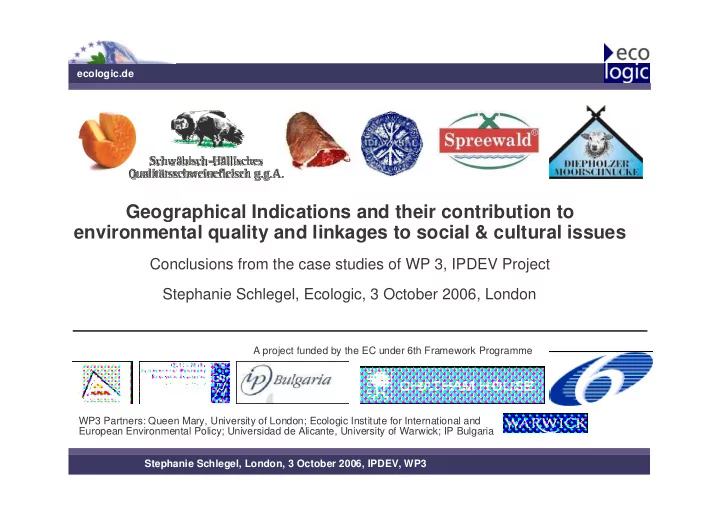

ecologic.de Geographical Indications and their contribution to environmental quality and linkages to social & cultural issues Conclusions from the case studies of WP 3, IPDEV Project Stephanie Schlegel, Ecologic, 3 October 2006, London A project funded by the EC under 6th Framework Programme WP3 Partners: Queen Mary, University of London; Ecologic Institute for International and European Environmental Policy; Universidad de Alicante, University of Warwick; IP Bulgaria Stephanie Schlegel, London, 3 October 2006, IPDEV, WP3
ecologic.de ecologic.de Content 1. GIs and their contribution to environmental quality • Methodology • Impact Assessment of case studies and conclusions • Other dimensions of the relation between the protected product and environmental objectives 2. Linkages of GIs to social and cultural issues • Link to regional identity , employment and local traditions • Synergies with other sectors Datum Stephanie Schlegel, London, 3 October 2006, IPDEV, WP3 2
ecologic.de ecologic.de Role of environmental considerations for GI Significance of environmental considerations in objectives and specification of the GI: • primary motivation in most cases economic one • environmental requirements rarely included explicitly in the specification Datum Stephanie Schlegel, London, 3 October 2006, IPDEV, WP3 3
ecologic.de ecologic.de Methodology - Environmental Impact Assessment Impact Assessment, based on the observation of indicators : • Biodiversity • Water • Soil • Landscape and cultural heritage • Others: use of natural resources and energy, air/climate, waste Assessment of specific effects set forward by GI/ comparison to reference situation 1. land-use criterion (alternative land use) 2. product-based criterion (product substitute) Datum Stephanie Schlegel, London, 3 October 2006, IPDEV, WP3 4
Prod. group Gherkins Potatoes Cheese Meat (pork) Cheese Meat (lamb) Extra virgin Rice (ewe milk) (cow milk) olive oil ecologic.de ecologic.de GI Spreewald Jersey Idiazabal SHQ WCFC Diepholz Sierra Arroz de Gherkin Royal Moorsheep Mágina Valencia Potatoes Env. Issue +/- + + + ++ +/- + Overall env +/- performance +/0 + + + ++ +/- + Biodiversity +/0 Water - 0/- 0 0/+ +/- 0/+ +/- + -/0 0/- +/0 0/+ + + +/- +/- Soil + + + + + + + + Landscape +/0 + + + + + -/+ Others - + - + + + + Prod. In natural + reserve + + + + + + - Organic - production Intensification Intensive , but Intensified , Not intensified Not intensified Not intensified Not intensified Intensified , Not reduction efforts reduction efforts reduction efforts intensified , reduction efforts Requirements in - 0/+ + - + - - + Specification - 0/- + - + - 0/- Env. Qual. as - motivating factor Env. Aspects in 0 0/+ + + +/0 0/+ + Marketing Importance label +/- - + - - (growing) - - - (growing) Table 1: overview of environmental impacts in each case study and other dimensions of the relation between the protected product and environmental objectives Datum Stephanie Schlegel, London, 3 October 2006, IPDEV, WP3 5
ecologic.de ecologic.de Environmental Impacts - Conclusions Production processes of the different GIs vary greatly - effects of production vary substantially (from environmentally beneficial GIs, to GIs with neutral or ambiguous effects on the environment) GIs are not an environmental safeguard for sustainable and extensive production Intensification of production is also a concern for GI goods, although effects are frequently addressed by mitigation strategies Common to most case studies: short production chains which reduces the use of natural resources and energy. If environmental quality was a motivating factor leading to the establishment of GI protection, the product is more likely to achieve an environmental benefit. Datum Stephanie Schlegel, London, 3 October 2006, IPDEV, WP3 6
ecologic.de ecologic.de Other relations between product and env. objectives • The environmental benefits often achieved through indirect secondary effects • price premium associated with the GI protection enables farmers to maintain environmentally friendly production methods, or to support environmentally beneficial flanking measures • synergies with other sectors such as tourism contribute to the protection of traditional landscapes and habitats • In many cases, environmental benefits are put forward not by the GI but by EU and national agricultural support measures. Datum Stephanie Schlegel, London, 3 October 2006, IPDEV, WP3 7
ecologic.de ecologic.de 2.2 Social interlinkages - Synergies with other sectors • Improve image of the region/ advertise and strenghten the profile and attractiveness of the region: • Strong synergies with tourism sector • Maintenance of certain distinctive landscape characteristics /natural heritage • Preservation of natural ressources (some cases) • Integral part of local events (celebration of local traditions) • GI protected products often element of/ benefiting from regional development projects / involvement in wider community activities • Identification for farmers in the region/ establishment of networks Datum Stephanie Schlegel, London, 3 October 2006, IPDEV, WP3 8
ecologic.de Thank you for listening! Stephanie Schlegel Ecologic, Pfalzburger Str. 43-44, D-10717 Berlin � � � � +49-30-86880-0, � � � � +49-30-86880-100 schlegel@ecologic.de, www.ecologic.de Stephanie Schlegel, London, 3 October 2006, IPDEV, WP3
Recommend
More recommend